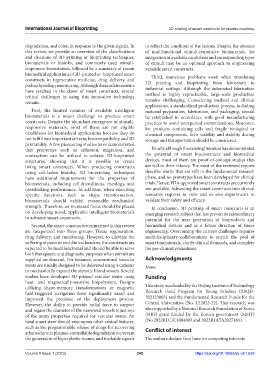Page 257 - IJB-9-1
P. 257
International Journal of Bioprinting 3D printing of smart constructs for precise medicine
degradation, and color, in response to the given signals. In to reflect the condition of the lesions. Despite the absence
this review, we provide an overview of the classifications of multifunctional stimuli-responsive biomaterials, the
and divisions of 3D printing or bioprinting techniques, integration of available candidates and corresponding types
biomaterials or bioinks, and commonly used stimuli- of stimuli may be an optional approach to engineering
responsive biomaterials, followed by a summary of recent versatile smart constructs.
biomedical applications of 3D-printed or -bioprinted smart Third, numerous problems await when translating
constructs in regenerative medicine, drug delivery, and 3D printing and bioprinting from laboratory to
pathophysiology monitoring. Although these achievements industrial settings. Although the automated fabrication
have resulted in the dawn of smart constructs, several
critical challenges in using this innovative technology method is highly reproducible, large-scale production
remain. remains challenging. Considering medical and clinical
applications, a standardized production process, including
First, the limited number of available intelligent material preparation, fabrication, and packaging, should
biomaterials is a major challenge to produce smart be established in accordance with good manufacturing
constructs. Despite the abundant emergence of stimuli- practices to avoid unexpected contaminations. Moreover,
responsive materials, most of them are not eligible for products containing cells and fragile biological or
candidates for biomedical applications because they do chemical components, their viability and stability during
not fulfill two important criteria, biocompatibility and 3D storage and transportation should be considered.
printability. A few pioneering studies have demonstrated
that properties such as adhesion, migration, and Finally, although the existing literature has demonstrated
contraction can be utilized to actuate 3D-bioprinted the potential of smart bioconstructs and biomedical
structures, showing that it is possible to create devices, most of them are proof-of-concept studies that
living smart constructs. When producing constructs are still in their infancy. The most of the reviewed reports
using cell-laden bioinks, 3D bioprinting techniques describe works that are still in the fundamental research
have additional requirements for the properties of phase, and no prototypes have been developed for clinical
biomaterials, including cell-friendliness, rheology, and trials. Hence, FDA-approved smart constructs are currently
crosslinking performance. In addition, when executing not available. Advancing the smart constructs into clinical
specific functions, such as shape transformation, scenarios requires in vitro and in vivo experiments to
biomaterials should exhibit reasonable mechanical validate their safety and efficacy.
strength. Therefore, an increased focus should be placed In conclusion, 3D printing of smart constructs is an
on developing novel, applicable intelligent biomaterials emerging research subject that has proven its extraordinary
to advance smart constructs. potential for the next generation of bioproducts and
Second, the smart constructs summarized in this review biomedical devices and as a future direction of tissue
are categorized into three groups: Tissue regeneration, engineering. Overcoming the current challenges requires
drug delivery, and monitoring. However, to alleviate the multidisciplinary collaborations to enrich the pool of
suffering of patients and clinical burdens, the constructs are smart biomaterials, clarify clinical demands, and complete
expected to be multifunctional and should be able to serve the pre-clinical evaluations.
both therapeutic and diagnostic purposes when stimuli are
supplied on demand. For instance, conventional vascular Acknowledgments
stents are usually designed to be delivered using a catheter None.
to mechanically expand the stenotic blood vessels. Several
studies have developed 3D-printed vascular stents using Funding
heat- and magnetically-sensitive biopolymers. Designs
utilizing shape-memory transformations or magnetic This study was funded by the Beijing Institute of Technology
field-triggered navigation have significantly eased and Research Fund Program for Young Scholars (XSQD-
improved the precision of the deployment process. 202123003) and the Fundamental Research Funds for the
However, the ability to provide radial force to support Central Universities (No. LY2022-22). This research was
and regain the diameter of the narrowed vessels is just one also supported by a National Research Foundation of Korea
of the many properties required for vascular stents. An (NRF) grant funded by the Korean government (MSIT)
ideal smart stent should encompass other critical features, (No.2022R1C1C1004803 and 2022R1A5A2027161).
such as the programmable release of drugs for recovering Conflict of interest
atherosclerotic plaques, controllable degradation to prevent
the generation of hyperplastic tissues, and trackable signals The authors declare they have no competing interests.
Volume 9 Issue 1 (2023) 249 https://doi.org/10.18063/ijb.v9i1.638

